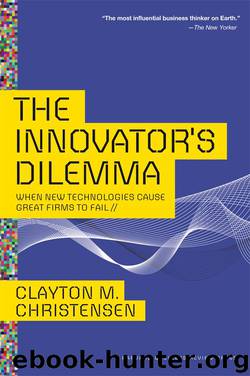The Innovator's Dilemma: When New Technologies Cause Great Firms to Fail (Management of Innovation and Change) by Clayton M. Christensen

Author:Clayton M. Christensen [Christensen, Clayton M.]
Language: eng
Format: epub, mobi
ISBN: 9780875845852
Publisher: Harvard Business Review Press
Published: 2013-10-21T22:00:00+00:00
KRESGE, WOOLWORTH, AND DISCOUNT RETAILING
In few industries has the impact of disruptive technology been felt so pervasively as in retailing, where discounters seized dominance from traditional department and variety stores. The technology of discount retailing was disruptive to traditional operations because the quality of service and selection offered by discounters played havoc with the accustomed metrics of quality retailing. Moreover, the cost structure required to compete profitably in discount retailing was fundamentally different than that which department stores had developed to compete within their value networks.
The first discount store was Korvette’s, which began operating a number of outlets in New York in the mid-1950s. Korvette’s and its imitators operated at the very low end of retailing’s product line, selling nationally known brands of standard hard goods at 20 to 40 percent below department store prices. They focused on products that “sold themselves” because customers already knew how to use them. Relying on national brand image to establish the value and quality of their products, these discounters eliminated the need for knowledgeable salespeople; they also focused on the group of customers least attractive to mainstream retailers: “young wives of blue collar workers with young children.” 9 This was counter to the upscale formulas department stores historically had used to define quality retailing and to improve profits.
Discounters didn’t accept lower profits than those of traditional retailers, however; they just earned their profits through a different formula. In the simplest terms, retailers cover their costs through the gross margin, or markup, they charge over the cost of the merchandise they sell. Traditional department stores historically marked merchandise up by 40 percent and turned their inventory over four times in a year—that is, they earned 40 percent on the amount they invested in inventory, four times during the year, for a total return on inventory investment of 160 percent. Variety stores earned somewhat lower profits through a formula similar to that used by the department stores. Discount retailers earned a return on inventory investment similar to that of department stores, but through a different model: low gross margins and high inventory turns. Table 5.1 summarizes the three positions.
The history of discount retailing vividly recalls the history of minimill steel making. Just like the minimills, discounters took advantage of their cost structure to move upmarket and seize share from competing traditional retailers at a stunning rate: first at the low end, in brand-name hard goods such as hardware, small appliances, and luggage, and later in territory further to the northeast such as home furnishings and clothing. Figure 5.2 illustrates how stunning the discounters’ invasion was: Their share of retailing revenues in the categories of goods they sold rose from 10 percent in 1960 to nearly 40 percent a scant six years later.
Download
The Innovator's Dilemma: When New Technologies Cause Great Firms to Fail (Management of Innovation and Change) by Clayton M. Christensen.mobi
This site does not store any files on its server. We only index and link to content provided by other sites. Please contact the content providers to delete copyright contents if any and email us, we'll remove relevant links or contents immediately.
Hit Refresh by Satya Nadella(8854)
The Compound Effect by Darren Hardy(8508)
Change Your Questions, Change Your Life by Marilee Adams(7371)
Nudge - Improving Decisions about Health, Wealth, and Happiness by Thaler Sunstein(7240)
The Black Swan by Nassim Nicholas Taleb(6762)
Deep Work by Cal Newport(6562)
Daring Greatly by Brene Brown(6221)
Rich Dad Poor Dad by Robert T. Kiyosaki(6174)
Principles: Life and Work by Ray Dalio(5957)
Man-made Catastrophes and Risk Information Concealment by Dmitry Chernov & Didier Sornette(5645)
Playing to Win_ How Strategy Really Works by A.G. Lafley & Roger L. Martin(5492)
Digital Minimalism by Cal Newport;(5389)
Big Magic: Creative Living Beyond Fear by Elizabeth Gilbert(5351)
The Myth of the Strong Leader by Archie Brown(5237)
The Slight Edge by Jeff Olson(5199)
Discipline Equals Freedom by Jocko Willink(5156)
The Motivation Myth by Jeff Haden(5000)
Stone's Rules by Roger Stone(4853)
The Laws of Human Nature by Robert Greene(4770)
